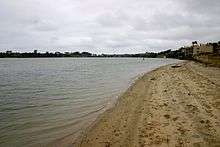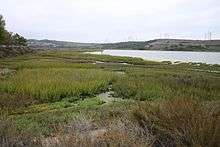Agua Hedionda Lagoon




The Agua Hedionda Lagoon ("agua hedionda" means "pestilent water" in Spanish) is a lagoon in Carlsbad, California, that is fed by the Agua Hedionda Creek. Stewardship of much of the lagoon is held by the Encina Power Station and its owner NRG Energy. In November 2000 the Agua Hedionda Lagoon was designated as a critical habitat for the tidewater goby.[1]
Public access
The Agua Hedionda Lagoon is open to the public as a passive recreation area. The lagoon is known as a place to walk, and for stand-up paddleboard, kayaking, wakeboarding, waterskiing, jet skiing, and wave runnering. The lagoon is also a public social destination, with events and gatherings. The lagoon sees most of its visitors during summer. Its location within the city of Carlsbad leads to its occasional reference as the “Carlsbad Lagoon.”
Passive Recreation Areas Legal definition: "A passive recreation area is an undeveloped space or environmentally sensitive area that requires minimal development. Entities such as a parks department may maintain passive recreation areas for the well-being of the public and for the preservation of wildlife and the environment. The quality of the environment and "naturalness" of an area is the focus of the recreational experience in a passive recreation area."[2]
There is public access via Bay Shore Drive, which is open for walking traffic from sunrise to sunset. Walking is the primary way of visiting, and vehicles may not drive through when it is closed for pedestrian use. Vehicles are highly limited as it is not environmentally beneficial or safe on the shoreline.[3]
Regulations
Regulations are necessary for those that come to visit, in order to a reduce pollution on the lagoon, including a prohibition on alcohol consumption. One of the biggest regulations would be alcohol regulation due to the bottles and cans that are potentially left on the lagoon and can harm the endangered species that are present.
The use of parasailing, a hovercraft, cabin cruisers, motorized surfboards, and aircraft are prohibited on the shorelines of bay. Visitors are also forbidden from leaving vessels on the lagoon. Public events must be approved by the City of Carlsbad Parks and Recreations Department and during these scheduled proceedings, swimming and/or wading is not allowed.[4] A vessel permit is required for launching access from the bay shoreline.
Fishing and boating
Fishing is a popular activity at this lagoon, however limitations are also implemented. There are designated fishing areas in the lower east end of the lagoon due to algae preventing quality fishing in other parts of the lagoon. Those who are fishing on a boat are not allowed to anchor, because doing so would disrupt the lagoon’s natural environment as well as endanger the species that live in the waters. In addition, all California Fish and Game Laws are highly enforced during this activity. There is a fishing license requirement for those that are 16 years and older. Shoreline fishing is allowed from all public access shorelines in all parts of the lagoon, fishing from a vessel is only allowed in the passive recreation areas.[5]
Agua Hedionda Lagoon Discovery Center
The Agua Hedionda Lagoon Discovery Center is a nature center for education about the local natural history, ecology, and cultural history of the lagoon and surrounding area. The Lagoon Discovery Center has an award-winning Environmental Stewardship School Program aimed at local 3rd graders which incorporates hands-on learning on Lagoon history, archaeology, Native American culture, migratory birds, and watersheds and wetlands.
The Discovery Center also holds numerous free family festivals throughout the year, as well as free monthly lectures and birding hikes. The center opened in 2006 and features a large California native plant garden, and expansive lagoon views. The natural habitat is Coastal sage scrub.
Dredging
Dredging Agua Hedionda Lagoon has occurred every two to four years since 1954.[6] Prior to the beginning of dredging, the lagoon was not connected to the Pacific Ocean.[6] There are 500,000 cubic yards of sand pulled up from the bottom of the lagoon through this dredging.[7] In 2014, about half of the sand pulled out went to a stretch of the beach between the intake and outlet jetties just outside the lagoon. The remaining sand was split between the beach at Tamarack and Oak Avenues, and the shoreline just south of the lagoon.
The Encina Power Station, owned by NRG Energy, is on the lagoon and pays for the dredging. The power plant was commissioned in 1954, which is when the first dredging was recorded. Its location on the lagoon's southern shore, allows the lagoon water to be used for cooling the power plant. This power station is fueled by non-renewable natural gas. It is one the main sources of energy in San Diego metropolitan area.
Lagoon dredging supports two aquaculture businesses in the Carlsbad vicinity: the Carlsbad Aqua Farm which raises and sells oysters and mussels; and the Hubbs-Seaworld Institute, which operates a hatchery for White Sea bass.[8]
According to Kasia Trojanowska, the Carlsbad Parks Planner, “the dredging puts sand back on the beach so that beach goers have a nice sandy spot to place their towels." Dredging maintains the tidal circulation of the lagoon and creates a larger beach that is free of rocks for a while.[7]
Desalinization plant
The Carlsbad desalination plant at the lagoon will be able provide 50 million gallons of desalinated water per day.[9] There are coastal and marine environmental concerns regarding the plant. By 2017, Poseidon Water will take over dredging responsibilities from NRG Energy.
References
- ↑ "Archived copy". Archived from the original on 2008-05-17. Retrieved 2008-03-02. The Carlsbad Watershed Network website
- ↑ "Passive Recreation Area Law & Legal Definition". www.definitions.uslegal.com. USLegal, Inc. Retrieved 9 December 2014.
- ↑ "Event Permitting". www.carlsbadca.gov. Retrieved 9 December 2014.
- ↑ "Parks & Recreation". www.carlsbadca.gov. Retrieved 9 December 2014.
- ↑ "Agua Hedionda Lagoon". www.sandiegocoastlife.com. San Diego Coast Life. Retrieved 9 December 2014.
- 1 2 Munoz, Eric (8 November 2007). "Desalination plant will help preserve Agua Hedionda Lagoon". San Diego Union Tribune. Retrieved 7 June 2015.
- 1 2 Sifuentes, Edward. "Agua Hedionda Lagoon dredging starts soon". www.utsandiego.com. UT San Diego. Retrieved 28 November 2014.
- ↑ "Preserving the Agua Hedionda Lagoon" (PDF). carlsbaddesal.com.
- ↑ "Carlsbad Project". poseidonwater.com. Retrieved 9 December 2014.
External links
Coordinates: 33°08′33″N 117°19′39″W / 33.14250°N 117.32750°W